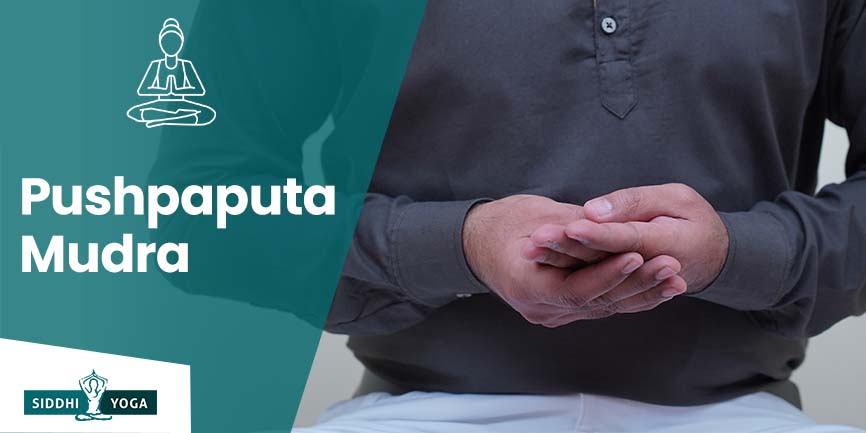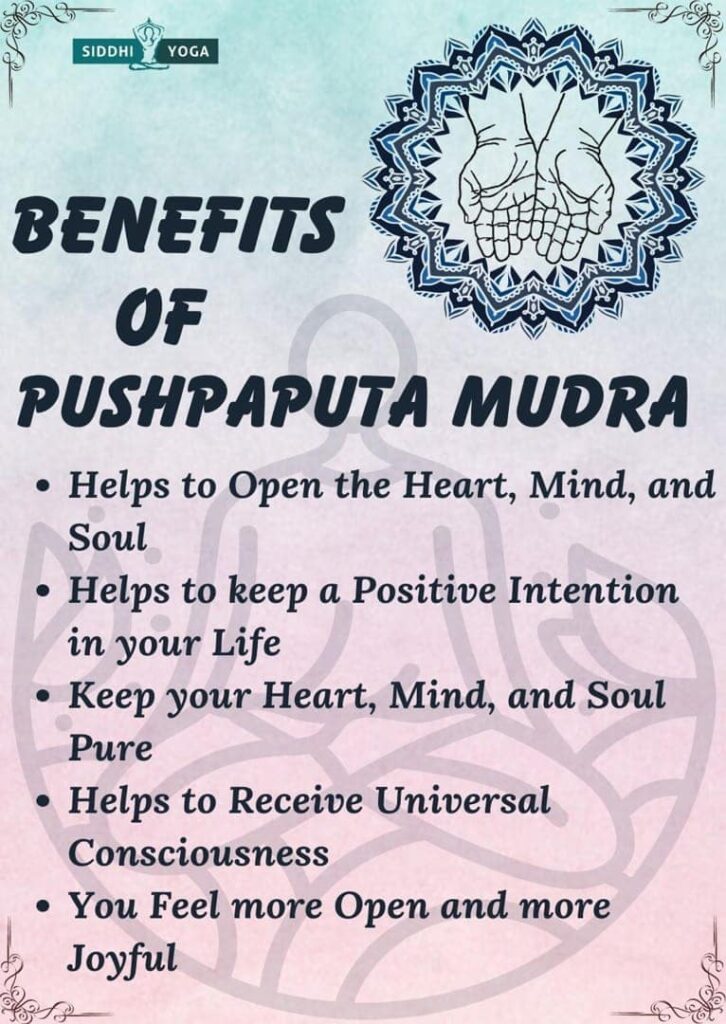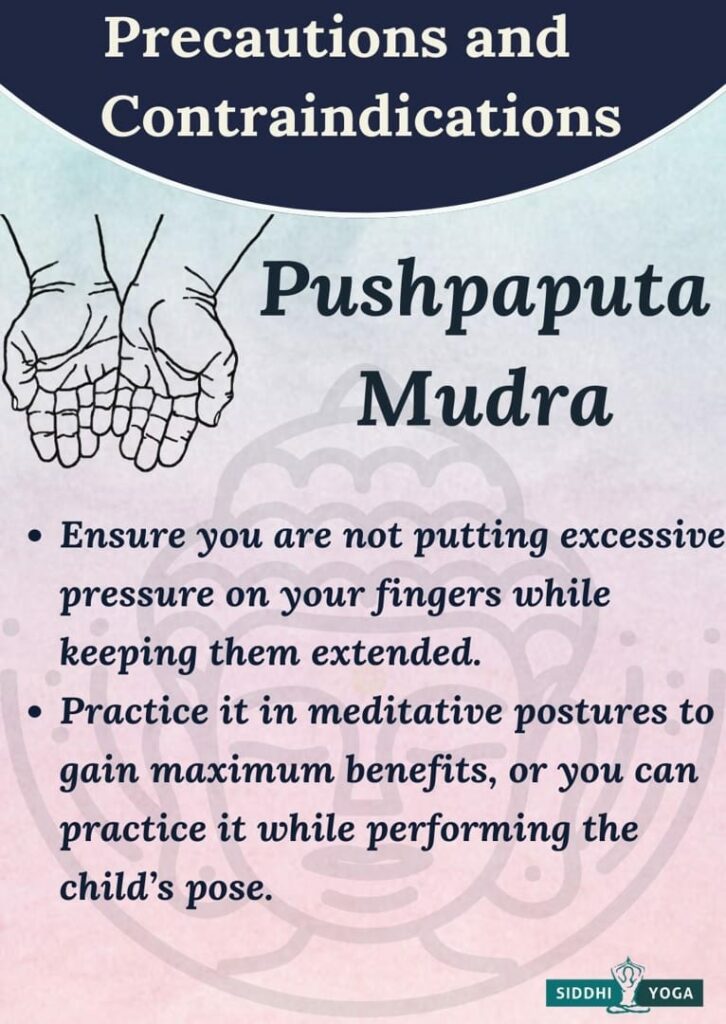
A step-by-step guide on the traditional yoga mudra called Pushpaputa Mudra. This article will help you understand what it is, how to do it & why we need this.
Definition – What is Pushpaputa Mudra and its Meaning, References, and Mythology?
Pushpaputa Mudra is a type of Hasta Mudra or Hand gesture/seal. Pushpaputa is one of the joint hand gestures. In this, we keep both of our hands in a similar position. To understand this Mudra, let us break it down into two different words.
Pushpaputa – This is a Sanskrit term that means a handful of flowers.
Mudra – Hasta Mudra or hand gesture/seal.
Collectively, this Mudra is aimed to offer a handful of flowers. Even if you visit Hindu temples, you will see that this Mudra is often used to offer flowers to the Hindu deities.
This Mudra emphasizes opening the heart, mind, and soul. By this, the practitioner sends a signal to this universe that I am open to new things, new challenges, new opportunities, and new adventures. Often, we do not realize that, in some way, we are blocking the path of new possibilities. Sometimes, due to bad experiences in our past and fear of getting hurt, we close the door to new things and new people. What we don’t realize is that we are not helping our situation; this can also cause suffering. So, practicing this Mudra helps to open all those blockages. You attract better things in your life. The universe has everything that you can wish for. It is just that we are not opening the gates which can bring us happiness.
The universe is pouring blessings. You must become a good vessel to accept it with a pure heart and soul. You attract things and people mainly based on your internal environment. If your internal environment is calm, pure, and peaceful, you will attract the same, but if your internal environment, your body, soul, and mind are not pure, you will attract otherwise. So, this is the reason why Maharshi Patanjali started eight-limb Yoga/ Asthanga Yoga in his book Yoga Sutra with Yama and Niyama, which focuses on the internal and external purity of the Yoga practitioner.
Alternate Name of Pushpaputa Mudra
“handful of flowers Mudra.”
How to do Pushpaputa Mudra?
- This Mudra does not require you to perform while seated in any meditative posture. This Mudra can also be practiced in standing posture (Mountain Pose/Samsthiti).
- It is believed that to maximize the benefits of this Mudra, you should practice it during meditation. You can start sitting in Vajrasana (Thunderbolt Posture) or Lotus Posture (Padma Asana).
- Rest both of your hands comfortably on your knees. Palms facing upward towards the sky.
- Keep all the fingers and thumb extended but they should remain joined together.
- Now, slowly and gently bring your hands slightly above the navel, and keep your arms half-bent.
- Now, slowly and gently join your palms together so that you try to form an empty vessel with your palms where you can carry a handful of flowers.
- There is a different method: bring your fingertips close to each other while your hands remain extended/half bend.
- Keep your neck and spine comfortably straight.
- Completely close your eyes.
- Practice deep breathing.
- You can perform this Mudra while practicing different forms of meditation and pranayama. This can even be practiced while performing the child’s pose.
Pushpaputa Mudra Benefits

- It helps to open the heart, mind, and soul. So, you become more open to new things and opportunities in your life.
- It helps to keep a positive intention in your life.
- If you keep your heart, mind, and soul pure, this brings universal blessings. It helps to attract better people into your life.
- This Mudra helps to receive universal consciousness in your life.
- You feel more open and more joyful.
Pushpaputa Mudra Precautions and Contraindications

- Ensure you are not putting excessive pressure on your fingers while keeping them extended.
- Practice it in meditative postures to gain maximum benefits, or you can practice it while performing the child’s pose.
When and how long to do Pushpaputa Mudra?
- This Mudra can be practiced when you feel that you want to attract better things and better opportunities in your life.
- If you find it difficult to surrender and let go.
- You can practice this if you somehow have blocked your positive energies.
Morning is the ideal time to do any yoga or Mudra. In the morning, during the daytime, our brain is at its best. So, you are more likely to be able to concentrate easily. Therefore, you should practice this Mudra from 4 am and 6 am to get the most effective outcomes.
If you are having difficulty with this during the morning, you can do this Mudra later in the evening too.
Practicing this Mudra for a minimum of 20-40 minutes daily is recommended. Whether you wish to complete it in one stretch or two threes that last between 10 and 15 minutes, it’s up to you. Based on research, the best way to practice an exercise for at least 20 minutes is to get the best benefits of that Mudra.
Breathing in Pushpaputa Mudra
To enhance your practice, you can practice breathing techniques with this Mudra.
- Abdominal breathing, when you inhale, let the belly come out and when you exhale, let the belly relax comfortably in.
Visualization in Pushpaputa Mudra
- Visualize that you are carrying a handful of flowers in your hand.
- These flowers are of your liking.
- Observe the fragrance of the flowers.
- This fragrance fills you inside and opens the gates of your heart for new things to enter.
Affirmation in Pushpaputa Mudra
While practicing this, Keep a positive intention. Start with:
“I am filled with joy; my heart is open to accept. My energies are pure. So I will attract pure people in my life.”
Conclusion
The Pushpaputa Mudra is an excellent mudra to increase concentration and memory while promoting self-confidence. If you are interested in learning more about this and other mudras, we offer a Mudras certification course that covers all 108 mudras. With this course, you’ll be able to learn the benefits of each Mudra and how to incorporate them into your daily life. Sign up today and start your journey toward becoming a certified Mudras practitioner!